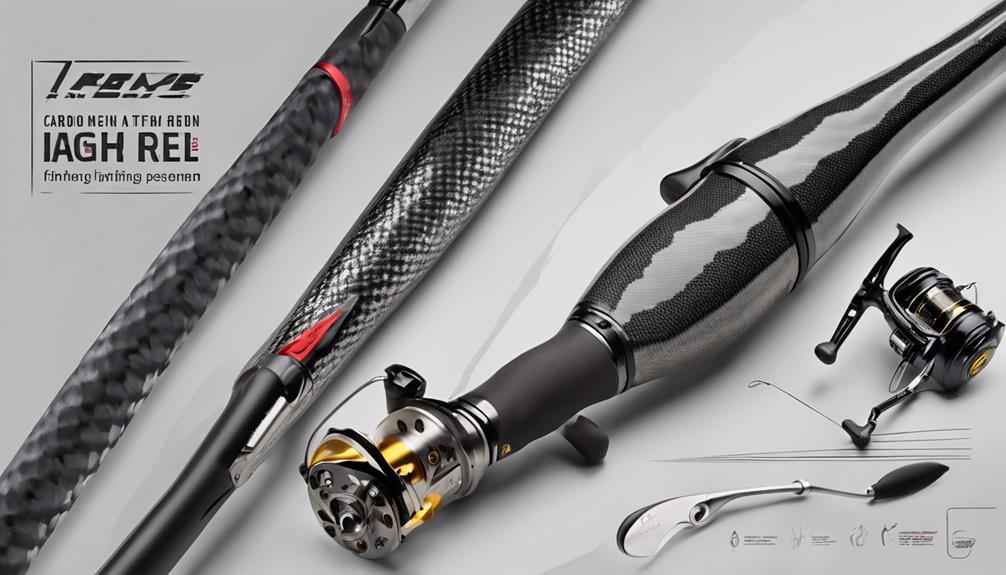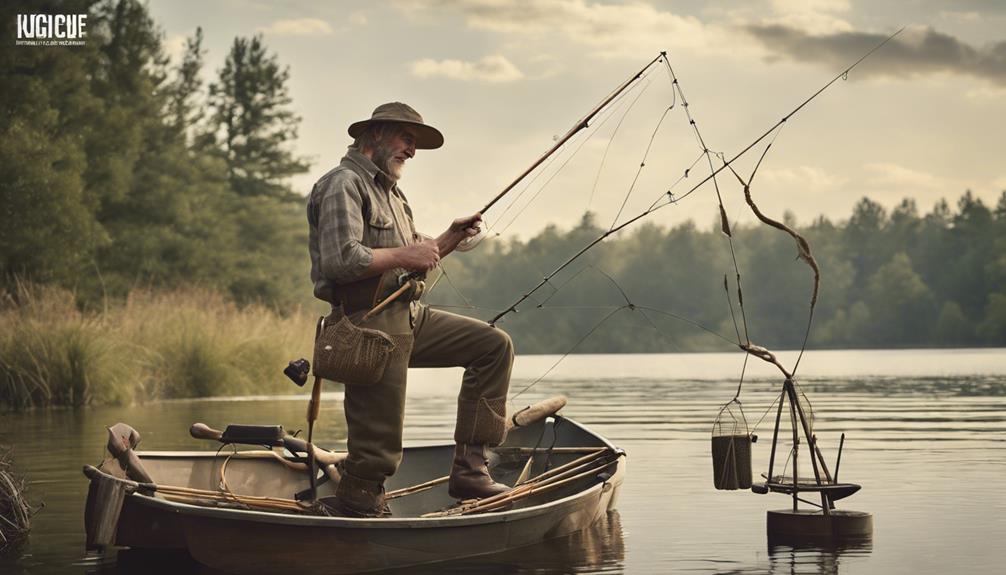Imagine angling gear as a river, constantly flowing and adapting to the landscape. Just like how the invention of the reel transformed the way anglers interacted with their prey, numerous other advancements have shaped the tools of the trade throughout history.
From the humble beginnings of handcrafted hooks to the intricate designs of modern rods, each innovation has played a crucial role in enhancing the angling experience. But what specific breakthroughs and discoveries have truly revolutionized angling equipment over the centuries?
Early Tools and Techniques
Early anglers crafted their tools and honed their techniques with resourcefulness and innovation, laying the foundation for the evolution of angling equipment. In the realm of primitive methods and ancient practices, fishing wasn't just a pastime but a crucial means of sustenance. Imagine yourself in those early days, fashioning simple hooks out of bone or sharpened wood, using makeshift lines woven from plant fibers. These ingenious methods were the building blocks upon which modern angling equipment would later stand.
As you delve into the history of angling, you discover the remarkable ways in which early anglers adapted to their environments. Across different cultures and regions, diverse techniques emerged, each tailored to the specific conditions of the waters they frequented. From handlining in rivers to spearfishing in coastal areas, ancient practices reflected a deep understanding of nature and its rhythms. The harmony between angler and environment was palpable, as they worked in concert to secure their next meal.
Through trial and error, these early anglers refined their tools and techniques, passing down their knowledge through generations. The evolution of angling equipment was a testament to human ingenuity, as each innovation built upon the successes and failures of the past. What started as humble beginnings with primitive methods and ancient practices would eventually blossom into the sophisticated gear we use today.
Rise of Reels and Lines
The evolution of angling equipment took a significant leap forward with the introduction of reels and lines, revolutionizing the way fishermen approached their craft. Reels transformed the mechanics of fishing, allowing for smoother casting and efficient line retrieval. Traditional hand-lining gave way to the convenience and precision of reel mechanics, enabling anglers to control their line with greater ease.
Line materials also underwent a revolution, moving from natural fibers like silk and horsehair to more durable synthetic materials such as nylon and fluorocarbon. These advancements in line technology improved strength, flexibility, and resistance to abrasion, providing anglers with more reliable tools for their fishing endeavors.
With the rise of reels and advanced line materials, casting techniques evolved. Anglers now had the ability to cast further distances with greater accuracy, reaching previously inaccessible fishing spots. Knot tying became essential for securing lines to reels and attaching hooks, lures, or swivels. Anglers mastered a variety of knots like the improved clinch knot and Palomar knot to ensure their setups were secure and reliable.
Innovation in Rod Designs
Revolutionizing angling experiences, modern advancements in rod designs have elevated fishing performance to new heights. Custom rod building has become increasingly popular among anglers seeking personalized equipment tailored to their specific needs. This trend allows for rods to be crafted with precise actions, lengths, and components, resulting in superior performance and comfort during fishing trips.
Cutting-edge materials play a pivotal role in the innovation of rod designs. Advanced materials such as carbon fiber, graphite, and fiberglass are now commonly used to construct rods that are lighter, stronger, and more sensitive than ever before. These materials also contribute to increased durability and responsiveness, providing anglers with the ability to detect even the slightest of bites.
In addition to materials, modern rod designs often incorporate innovative features such as improved reel seats, ergonomic grips, and specialized guides. These enhancements not only enhance the overall fishing experience but also cater to different fishing styles and techniques. For example, rods designed for casting long distances may have longer grips for increased leverage, while rods intended for finesse fishing may have ultra-sensitive tips for detecting subtle movements.
Evolution of Hooks and Baits
Advancements in hook and bait technology have transformed the way you approach your fishing strategies. The evolution of hooks and baits has been crucial in enhancing fishing techniques and bait development. Let's delve into how these advancements have influenced angling practices.
Bait evolution has played a significant role in attracting various fish species. From natural baits like worms and insects to artificial lures mimicking prey movements, the options available today are vast. This variety allows you to experiment with different baits to target specific fish or adapt to changing conditions on the water.
Hook styles have also evolved over time to cater to different fishing scenarios. Whether you're using a circle hook for catch-and-release fishing or a J-hook for a more traditional approach, selecting the right hook can greatly impact your success rate. The development of barbless hooks has gained popularity due to their easier hook removal and reduced harm to fish.
Incorporating these advancements into your fishing arsenal can give you a competitive edge. Understanding the intricacies of bait presentation and hook selection can make a significant difference in your overall fishing experience. So, next time you hit the water, consider the evolution of hooks and baits in refining your angling techniques.
Influence of Industrial Revolution
Industrialization during this period significantly reshaped the angling landscape, revolutionizing equipment manufacturing processes. The impact of the Industrial Revolution on angling equipment was profound, leading to significant changes in gear manufacturing. Here are four key ways in which this historical period influenced angling equipment:
- Mass Production: Industrialization enabled the mass production of fishing equipment, making rods, reels, and other gear more accessible to the general population. This mass production led to lower costs and increased availability of angling equipment.
- Standardization: The Industrial Revolution brought about standardization in gear manufacturing processes. This ensured that fishing equipment was produced uniformly, leading to greater consistency in quality and performance.
- Introduction of New Materials: The Industrial Revolution ushered in the use of new materials such as steel and aluminum in the manufacturing of fishing gear. These materials were more durable and lightweight, enhancing the overall quality of angling equipment.
- Technological Advancements: Industrialization spurred technological advancements in gear manufacturing, leading to innovations such as precision engineering in reels and rods. These advancements improved the efficiency and effectiveness of angling equipment, enhancing the angling experience for enthusiasts.
Impact of Technological Advancements
The evolution of angling equipment has been significantly shaped by technological progress, enhancing the functionality and performance of gear for fishing enthusiasts. Digital innovations have revolutionized angling, introducing concepts like smart fishing where anglers can use GPS, fish finders, and apps to enhance their fishing experience. These advancements have made it easier to locate fish, understand underwater structures, and optimize fishing techniques.
Nanotechnology has also made its mark in angling gear, leading to the development of eco-friendly equipment. Nanomaterials are being used to create stronger and lighter fishing rods, reels, and lines, reducing the environmental impact of fishing while enhancing durability and performance. Anglers now have access to gear that isn't only efficient but also sustainable, aligning with the growing focus on conservation and responsible angling practices.
The integration of digital technologies and nanotechnology into angling equipment has opened up a new realm of possibilities for fishing enthusiasts. Anglers can now enjoy a more immersive and environmentally conscious fishing experience, thanks to these technological advancements. As technology continues to advance, the future of angling equipment looks promising, with innovations that prioritize both performance and sustainability.
Modern Materials and Manufacturing

Modern materials and manufacturing techniques have revolutionized the angling equipment industry, enhancing the quality and performance of gear for fishing enthusiasts. This transformation has been driven by advancements in nanotechnology applications, synthetic fibers, carbon fiber development, and modern manufacturing techniques.
- Nanotechnology Applications: Nanotechnology has allowed for the development of stronger, lighter, and more durable fishing gear components. Nanomaterials are being used to enhance the strength and flexibility of fishing rods and reels, providing anglers with more reliable equipment.
- Synthetic Fibers: The use of synthetic fibers like nylon and polyester has replaced traditional materials such as cotton and silk in fishing lines and clothing. These synthetic fibers offer superior strength, abrasion resistance, and durability, making them ideal for withstanding the harsh conditions of fishing environments.
- Carbon Fiber Development: Carbon fiber has become a staple in modern fishing rod construction due to its exceptional strength-to-weight ratio. This material allows for the production of rods that aren't only lightweight and sensitive but also incredibly durable to handle large fish species.
- Modern Manufacturing Techniques: Advanced manufacturing processes such as computer numerical control (CNC) machining and 3D printing have revolutionized the production of angling equipment. These techniques enable precise and customizable fabrication of fishing gear, ensuring high quality and consistency across products.
Sustainability in Angling Gear
With a growing focus on environmental impact, sustainability is increasingly becoming a key consideration in the design and production of angling gear. Anglers like you're now seeking eco-friendly options that minimize harm to the environment while enjoying their favorite pastime. Manufacturers are responding to this demand by incorporating sustainable practices into their production processes.
When looking for sustainable angling gear, consider options made from recycled materials. Many companies are now using recycled plastics and other materials to create high-quality fishing rods, reels, and other equipment. These products not only perform well but also help reduce waste and lessen the reliance on new resources.
Another aspect of sustainability in angling gear is durability. By investing in well-made, long-lasting equipment, you can reduce the frequency of replacements and ultimately decrease your environmental footprint. Look for gear that's built to withstand the rigors of fishing and is less likely to end up in a landfill after a short period of use.
Moreover, choosing gear from companies that prioritize sustainable practices in their manufacturing processes can make a significant difference. Supporting businesses that are committed to reducing their environmental impact can encourage more widespread adoption of eco-friendly options in the angling industry. By making informed choices and opting for sustainable angling gear, you can enjoy your fishing adventures while contributing to a healthier planet.
Frequently Asked Questions
How Did Cultural Beliefs and Superstitions Impact the Development of Angling Equipment Throughout History?
When it comes to angling equipment, cultural beliefs and superstitions played a significant role in shaping its development. People's beliefs often influenced the design and materials used in fishing tools.
As innovations and technological advancements occurred, these traditional influences continued to impact the evolution of angling gear.
Over time, a blend of superstitions, cultural beliefs, and modern advancements have transformed angling equipment into what we use today.
What Role Did Women Play in the Evolution of Angling Gear?
When it comes to the evolution of angling gear, women's contributions have been significant. Their involvement in innovation in design and embracing technological advancements has pushed the boundaries of angling equipment.
Gender dynamics have shifted as more women have taken active roles in shaping the development of gear. Their insights and expertise have brought fresh perspectives to the industry, leading to more diverse and inclusive angling equipment options for all.
How Did Political Events or Conflicts Influence the Design and Production of Fishing Equipment?
Political conflicts and technological advancements have had a significant impact on the design and production of fishing equipment. During times of war or political unrest, resources were often diverted, leading to innovations in materials and manufacturing processes.
These events spurred the development of more durable and efficient angling gear, ultimately shaping the tools used by anglers throughout history.
Were There Any Famous Anglers or Fishing Tournaments That Significantly Shaped the Development of Angling Equipment?
When it comes to famous anglers and fishing tournaments, their influence on angling equipment development is substantial. Notable anglers like [Name] and renowned fishing tournaments such as [Event] have played key roles in shaping the gear we use today.
Their innovative techniques and preferences have pushed manufacturers to create more advanced and efficient equipment. As a result, the evolution of angling gear continues to be influenced by these prominent figures and events.
How Have Environmental Changes and Conservation Efforts Affected the Design and Use of Angling Gear Over Time?
When it comes to angling gear, sustainability practices have influenced design and material selection over time. As environmental changes occur, innovation in technology advancements has played a role in creating more eco-friendly options for anglers.
Conservation efforts have led to the development of gear that minimizes impact on aquatic ecosystems. By incorporating these principles, anglers can enjoy their sport while also contributing to the preservation of the environment.
Conclusion
You've seen how angling equipment has transformed through the ages, from simple tools and techniques to modern innovations driven by the Industrial Revolution and technological advancements.
With the evolution of rods, reels, lines, hooks, and baits, fishing gear has become more efficient and sustainable.
As materials and manufacturing techniques continue to improve, anglers can expect even more advancements in the future.
So next time you head out to fish, remember the long journey of angling equipment that got you there.



